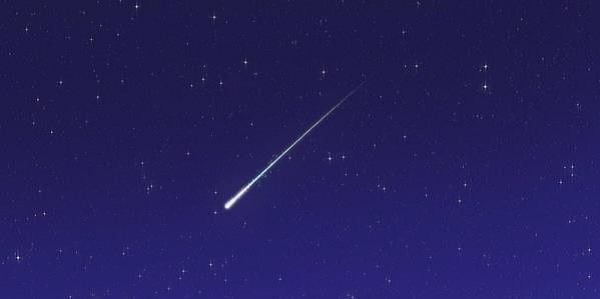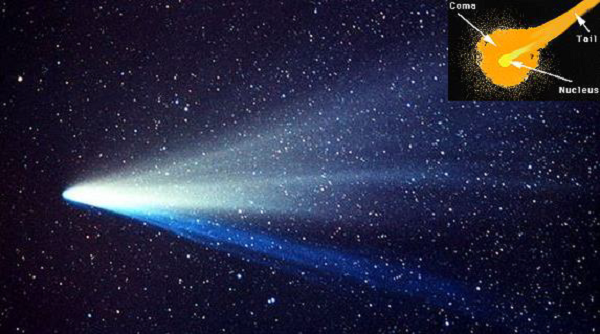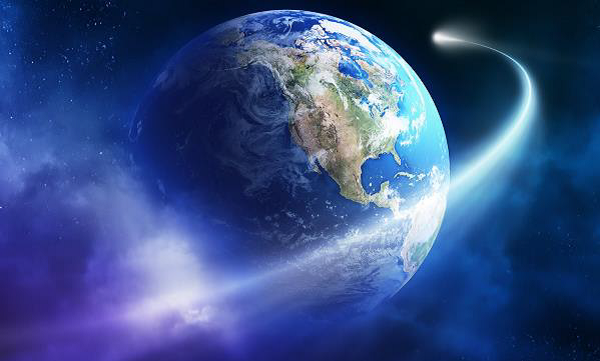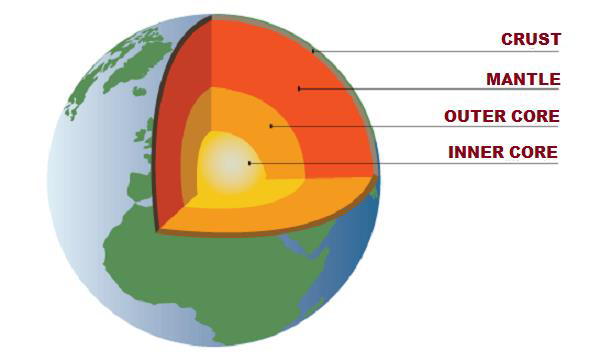Pythagoras, who was an Ionian Greek philosopher and mathematician, first used the term “COSMOS” for the order of the Universe.
Cosmology is the discipline that describes the large scale properties of the universe as a whole.
The distance covered by light in one year is known as “Light Year.” The Velocity of light is 300,000 km/s.
The distance between the Sun and the Earth is known as “Astronomical Unit.” One astronomical unit is (roughly) equal to 149.6 million kilometers.
Wilkinson Microwave Anisotropy Probe (WMAP) is an Explorer Mission of National Aeronautics and Space Administration (NASA). It is launched for the study and measurement of cosmology.
Professor Sir Fred Hoyle, who was an English astronomer, coined the term “Big Bang” to explain a scientific theory on the creation of cosmos.
Galaxy is a huge collection of stellar and interstellar matter, which are bound together by its own gravity in the Space. There are several galaxies in the universe, for example, Milky Way.
The name galaxy where we live is ‘Milky Way.’
The largest galaxy is ‘Andromeda Galaxy.’ It is also the closest to Milky Way. Milky Way is the second largest galaxy.
The radius of Milky Way is about 50,000 light years.
The Solar System is a part of Milky Way.
The Sun takes 225 million light years to complete one circuit.
The collapsed stars, which are immeasurably dense and having huge gravitational force (even light cannot escape rather get absorbed) are known as “Black Holes.”
Quasar is a massive and extremely remote celestial object that keeps emitting remarkably large amounts of energy. Typically, it has a star like image, which can be seen through the telescope.
Constellation is a group of stars being arranged in a pictorial configuration. It was basically observed by the ancient astronomers. For example, Sirius (Canis Major), Canopus (Carina), Turus (Bootes), etc.
Atacama Large Millimeter Array (ALMA) is the British Astronomy center, located at Chajnantor (at an altitude of about 5,000 meters), in the Atacama Desert of northern Chile.
Edwin Hubble, who was an American astronomer, first studied galaxies in detail. Based on Shape, Edwin classified galaxies as Elliptical, Spiral, and Barred Spiral.
At the end of life-cycle, when a star loses its light and the density increases (very high), by this time, it is largely composed of neutrons and hence known as ‘Neutron Star.’
Most likely, the rotating neutron star emits intermittent radio signals, is known as ‘Pulsar.’
A star with low temperature and small mass (glowing feebly) is known as ‘Red Dwarf.’
A star that suddenly increases its brightness (greatly) because of a catastrophic explosion and ejects most of its mass is known as ‘Supernova.’
Satellites (or Moons) are the bodies that keep revolving around their respective planets. For example, Moon revolves around the Earth, etc.
The Sun is the closest star to the Earth (at the distance of about 149,600,000 km).
Located at the distance of about 4.24 light-years, Proxima Centauri is the second closest star to the Earth.
The Sun is made up of extremely hot gasses and its glowing surface is known as the ‘Photosphere.’ The layer immediately above the photosphere is known as ‘Chromosphere’ (sphere of color).
The Chromosphere is 10,000 km thick transparent shell of plasma.
The Outermost layer of the Sun is known as the ‘Corona.’
Temperature of the outer surface is 6,0000 C and interior temperature is 15,000,0000 C.
The rotation period of the Sun is 25 days, 9 hours, and 7 minutes.
The traveling speed of the Sun’s Rays is 30,000 m/s.
The time taken by Sun’s Rays to reach the Earth is 8 minutes and 16.6 seconds.
The Sun is largely composed (chemically) of Hydrogen (71%), Helium (26.5%), and some other elements (2.5%).
Sometimes, in the photosphere, some patches of gas, which is cooler that its surrounding (gas) are known as the ‘Sunspots.’
The Planets are the celestial bodies that revolve around the Sun as well as (at the same time) rotate on their imaginary axis.
There are eight planets namely (arranged in the order of increasing distance from the Sun) −
Mercury
Venus
Earth
Mars
Jupiter
Saturn
Uranus
Neptune
The largest planet is Jupiter and Mercury is the smallest planet of the system.

Mercury
Mercury is the nearest to the Sun.
Mercury takes 58.65 Earth days to complete its rotation (on its axis) and takes 88 days to complete its one revolution (i.e. in its orbit around the Sun).
Mercury is the fastest planet and it has no moon (satellite).
Venus
Venus, which is also popular as an evening star and morning star, is the brightest celestial body in the universe after Sun and Moon.
Venus is the Hottest Planet of the solar system. It is closest to the Earth.
Venus takes 243 Earth days to complete its rotation (on its axis) and takes 224.7 days to complete its one revolution (i.e. in its orbit around the Sun).
Venus has no satellite and it spins in the opposite direction of the Earth’s spin.
Venus is named after the Roman goddess of Beauty.
Earth
Earth is the third planet from the Sun.
By the time, Earth is the only planet where life exists.
Earth takes 23 hours, 56 minutes, and 40 seconds to complete its rotation (on its axis) and takes 365.26 days to complete its one revolution (i.e. in its orbit around the Sun).
Mass of the Earth is 5.98 x 1024 kg and its diameter is 12,756 km.
Escape Velocity of the Earth is 11,200 m/s.
Obliquity (i.e. tilt of axis degrees) of the Earth is 23.40.
Mean density of the Earth is 5.514 g/cm3 and the surface is 510,072,000 km2.
Mean surface temperature of the Earth is 281 K; the mean maximum surface temperature is 310 K and the mean minimum surface temperature is 260 K.
The major atmospheric components of the Earth are Nitrogen (78%), Oxygen (20.95%), Argon (0.930%), and Carbon Dioxide (0.039%).
Moon
Moon is the only known satellite of the Earth.
Moons rotation time (on its axis) and revolution time (around the Earth) is same (i.e. 27 days, 7 hours, 43 minutes, and 11.47 seconds. This is the reason that we always see only one side of the Moon.
Moon revolves around the Earth once in every 27.3 days, which is known as ‘Sidereal Month;’ however, it takes 29.5 days to return to the same point on the celestial sphere in reference to the Sun (due to revolution motion of the Earth around the Sun) and it is known as ‘Synodic Month.’
When two full Moons occur in the same month, it is known as ‘Blue Moon.’
A Full Moon is basically the lunar phase that occurs when the Moon is completely illuminated as seen from the Earth.
As shown in the following image, the Lunar Phase or phase of the moon, is the shape of the illuminated portion of the Moon that is visible from the Earth. As Moon revolves, the lunar phases change cyclically and we can see from the full moon (full visible) to the new moon (not at all visible).

Mars
Mars is known as the ‘Red Planet’ of the solar system.
Mars takes 24 hours, 37 minutes, and 30 seconds to complete its rotation (on its axis) and takes 687 days to complete its one revolution (i.e. in its orbit around the Sun).
Mars has two satellites namely Phobos (means fear) and Deimos (means terror).
Jupiter
Jupiter takes 9 hours, 50 minutes, and 30 seconds to complete its rotation (on its axis) and takes 12 earth years to complete its one revolution (i.e. in its orbit around the Sun).
Jupiter has 63 natural satellites/moon, significant of them are Europa, Ganymede, Callisto, etc. Among all, Ganymede is the largest satellite in the whole solar system.
Saturn
Saturn is the largest planet after Jupiter in the solar system.
Saturn is popular for its spectacular rings system.
The rings system of Saturn is made up of a variety of separate particles that rotate in circular orbits independently.
Saturn takes 10 hours and 14 minutes to complete its rotation (on its axis) and takes 30 years to complete its one revolution (i.e. in its orbit around the Sun).
Saturn has total 47 satellites/moons; among them, Titan is the biggest satellite.
Uranus
Uranus is first identified as planet by William Herschel in 1781.
Like Saturn, Uranus also has a system of five faint rings.
Uranus takes 16 hours to complete its rotation (on its axis) and takes 84 years to complete its one revolution (i.e. in its orbit around the Sun).
Uranus has 27 satellites; significant of them are Miranda, Ariel, Umbriel, Titania, etc.
Neptune
Neptune is the farthest planet which appears greenish through a telescope.
Neptune is discovered by Berlin scientist J. G. Galle in 1846.
Neptune takes 18 hours to complete its rotation (on its axis) and takes 165 years to complete its one revolution (i.e. in its orbit around the Sun).
Neptune has 13 satellites/moons; significant of them are ‘Triton’ and ‘Nereid.’
Until 2006, there were nine planets (including Pluto), but in 2006, the ninth planet Pluto is categorized as the dwarf planet by International Astronomical Union (IAU).
Asteroids
Asteroids, also known as small planets or planetoids, are the rocky debris largely found between the planets Mars and Jupiter. These are too small to have their own atmosphere (as shown in the following image).

The Asteroids revolve around the Sun, which varies from 3 to 10 years.
By the time, more than 450,000 Asteroids are discovered; the largest Asteroid is Ceres, which diameter is about 1,025 km.
Meteors
Meteors, also popular as ‘Shooting Star’ or ‘Falling Star,’ is the passage of a comet, asteroid, or meteoroid into the Earth's atmosphere. It is heated (because of the collisions with air particles) and normally seen in the upper atmosphere (as shown in the following image).

Meteoroids are the small rocky or metallic bodies that normally travel through outer space. Meteoroids are expressively smaller than asteroids, and its size ranges from small grains to 1-meter-wide objects.
Comets
Comets are the icy small Solar System body; normally while passing close to the Sun, heats up and starts to outgas, displaying a visible atmosphere (i.e. basically coma) along with a tail (as shown in the following image – in the insat view).

Total surface area of the Earth is 510,100,500 sq. km, out of which −
The total land area is 148,950,800 sq. km (29.08% of total area) and
The total water area is 361,149,700 sq. km (70.92%).
Diameter of the Earth at Equator is 12,755 km, at the poles 12,712 km, and mean diameter is 12,734 km.

Circumference of the Earth at Equator is 40,075 km and at the poles 40,024 km.
Equatorial radius of the Earth is 6,377 km.
The total mass of the Earth is 5.98 x 1024 kg.
Approximate age of the Earth is 4,500 million years.
The mean velocity of the Earth in its orbit (around the Sun) is 107,218 km/h.
The most abundant elements of the Earth are
Iron (about 32.5%),
Oxygen (29.8%),
Silicon (15.6%), and
Magnesium (13.9%)
Structure of Earth
The Earth is structured in three layers namely −
Crust,
Mantle, and
Core – Further classified as outer core (fluid layer) and inner core (solid layer).

The Crust is the uppermost layer of the Earth, largely composed of rocks. Its thickness ranges from 5 km to 60 km and density ranges from 2.7 to 3.
The Crust shares about 1 percent of Earth’s volume.
The Crust is categorized as ‘Continental Crust’ and ‘Oceanic Crust.’
The thickness of Continental Crust ranges from 30 km to 50 km. It is largely composed by granites, which density (i.e. 2.7) is lesser than the Oceanic Crust.
The thickness of Oceanic Crust ranges from 5 km to 10 km and it is composed primarily of basalt, diabase, and gabbro.
The density of Oceanic Crust is 3.0.
The most abundant element of Crust is Oxygen (46.6%) followed by Silicon (27.7%) and Aluminum (8.1%).
The Crust is also known as ‘Sial’ (i.e. Silicon and Aluminum)
The boundary between the Crust and the Mantle is known as the “Mohorovičić Discontinuity.”
The Mantle is located between the Crust and the (Outer) Core, which thickness is about 2885 km.
The Mantle shares about 83% of the Earth’s volume and about 65% of the mass.
The density of Mantle is about 3.4 g/cm3.
The upper layer of Mantle is known as ‘Asthenosphere.’
The Crust and the upper part of Mantle collectively known as ‘Lithosphere.’
The Core is mostly composed of iron and nickel; therefore, it is also known as ‘Nife’ (i.e. Nickel and Ferrous).
The Core shares about 16% of Earth’s total volume and 30% of the mass.
The thickness of the Core is about 3,400 km from the Mantle (likewise, the total depth from the Surface of the Earth is 6,300 km).
Core is categorized as outer core (which is in molten state) and inner core (which is in solid state).
Density of the inner core is about 13 g/cm3.
ಭಾನುವಾರ, ಆಗಸ್ಟ್ 1, 2021
The universe and planet (geography)
ಇದಕ್ಕೆ ಸಬ್ಸ್ಕ್ರೈಬ್ ಆಗಿ:
ಕಾಮೆಂಟ್ಗಳನ್ನು ಪೋಸ್ಟ್ ಮಾಡಿ (Atom)

ಕಾಮೆಂಟ್ಗಳಿಲ್ಲ:
ಕಾಮೆಂಟ್ ಪೋಸ್ಟ್ ಮಾಡಿ